
Contents:
- Create An Opportunity Catalog
- Establish A Competency Framework
- Scaffold Competencies With Gamification
- Career Readiness Articulation
Millennials and Gen Z have been accused of killing so many industries and practices, it can be hard to keep up. But according to several recent surveys of college students and alumni, you may soon be able to add University Career Services to that long list.
Yes it’s true, Gen Z students aren’t going to the Career Center like their predecessors. But like most of the things Gen Z members are accused of ‘killing,’ the fault may lie instead with outdated systems that have not kept up with changing interests, needs and norms of America’s largest demographic.
First, the facts. If you look across several recent surveys, you see the negative trendlines come into focus. Outdated communications systems, antiquated messaging and a lack of connection with local and national employers have left students wanting more.
- According to the 2020 National Alumni Career Mobility Survey from the Career Leadership Collective, only 30% of alumni surveyed report receiving any helpful career advice from their university at all.
- According to the 2020 Student Viewpoint survey from College Pulse and Strada Education, just 35 percent of respondents said their college is excellent or very good at connecting education to meaningful careers.
- A 2020 qualitative study by students at UC Davis found that students were routinely frustrated after receiving career advice that was outdated or uninformed, especially after the pandemic hit.
In the case of the UC Davis study, author Livia Morris spoke with Inside Higher Ed and had this to say:
“There was already this void in up-to-date, actionable career advice for students, really modern career advice and an infrastructure to distribute that information. And it’s even worse now when you throw a global pandemic into the mix.”
Given these indictments, some commentators have pondered if the post-pandemic campus needs career centers at all
Well not so fast. Because while students may be frustrated with their school’s handling of career services, studies show that they are at least somewhat effective for the students who use them.
For example, the same 2020 National Alumni Career Mobility Survey that reported such low numbers of students receiving helpful career advice also offered some surprising insights about the ones who do.
- 92.7% of alumni in the most upwardly mobile group surveyed reported receiving helpful career advice that guided them long after graduation.
- That same group was 3 times more likely to have had an internship related to their current career.
- Those who received helpful career advice scored 32% higher in educational satisfaction than those who did not.
These facts make it clear that career centers still have an important role to play in improving career mobility and educational satisfaction in students long after graduation.
The question for career services professionals and university leaders is clear: How do we connect all of the co-curricular and experiential learning offerings that we have in place at our institutions to help students be successful after they graduate? How do we infuse career readiness more seamlessly into our university experience so we remain relevant and impactful? And perhaps most importantly, how do we build trust and help students to see the connection between their educational activities each day and the career they hope to one day hold?
In this guide, we’ll share some tips on how your school can help students visualize their learning and articulate their skills to achieve career success. Let’s begin.
Create An Opportunity Catalog
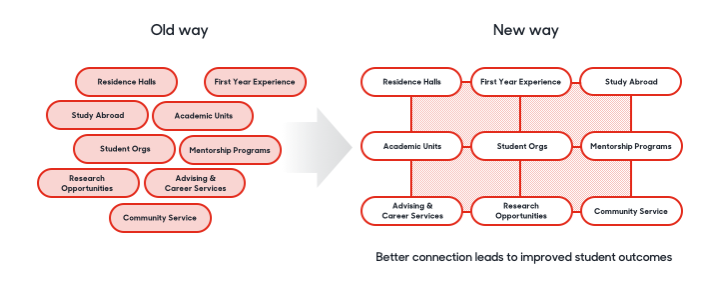
In her 2019 report “College Students: How To Make Office Hours Less Scary,” NPR reporter Elissa Nadworny spoke with college students across the country who were afraid to attend office hours.
Even when students knew they were heading in for positive feedback or much-needed assistance, the feedback was clear: office hours are intimidating, and students will avoid them if they can.
But, as Harvard University professor Anthony Abraham Jack told Nadworny, office hours can be essential to a student’s success.
“You gain access to institutional resources, you gain access to a professor's network. You gain access to a professor's support — for adventures and experiences that you may not even know about."
This report will likely sound familiar to many administrators who run programs they know are successful--if students would only take advantage of them.
But study after study reveals first-year students describe campus as “intimidating” and report not speaking up in class, being afraid to make new friends and finding it difficult to make connections with professors.
One way colleges can get students started with confidence is by offering an Opportunity Catalog. This catalog would document all the available outside-the-classroom opportunities students can take advantage of within their major and beyond. This can have a number of benefits for students just getting started.
Allow For Interaction With Professors
As Harvard Professor Anthony Abraham Jack told NPR, networking with professors is essential for student success. Not only does it open students to new opportunities and help them better understand course materials, it diversifies positive references for students when they go into graduate school or the workforce.
But how can students connect with their professors if they are too intimidated to attend office hours?
With an Opportunity Catalog, students can find outside-the-classroom activities hosted by their professors or in their majors. This allows for actionable ways to get to know students, TAs and faculty in your particular discipline, making the process a whole lot less scary.
Identify High Impact Practices (HIPs)
Every college or university offers a whole range of activities and opportunities for growth. But not all activities work for every student. Unfortunately, when you first start out as a college student, it can be hard to tell which experiences are going to be most beneficial to you.
Fortunately, there are certain activities that engage students in active learning, open them up to new experiences and will look especially good to employers down the line. By identifying these practices right up front, it lets students know where to go starting day 1 and can inform them of relevant ways to engage, network and experience campus in a more natural (and hopefully fun) way.
Establish A Competency Framework
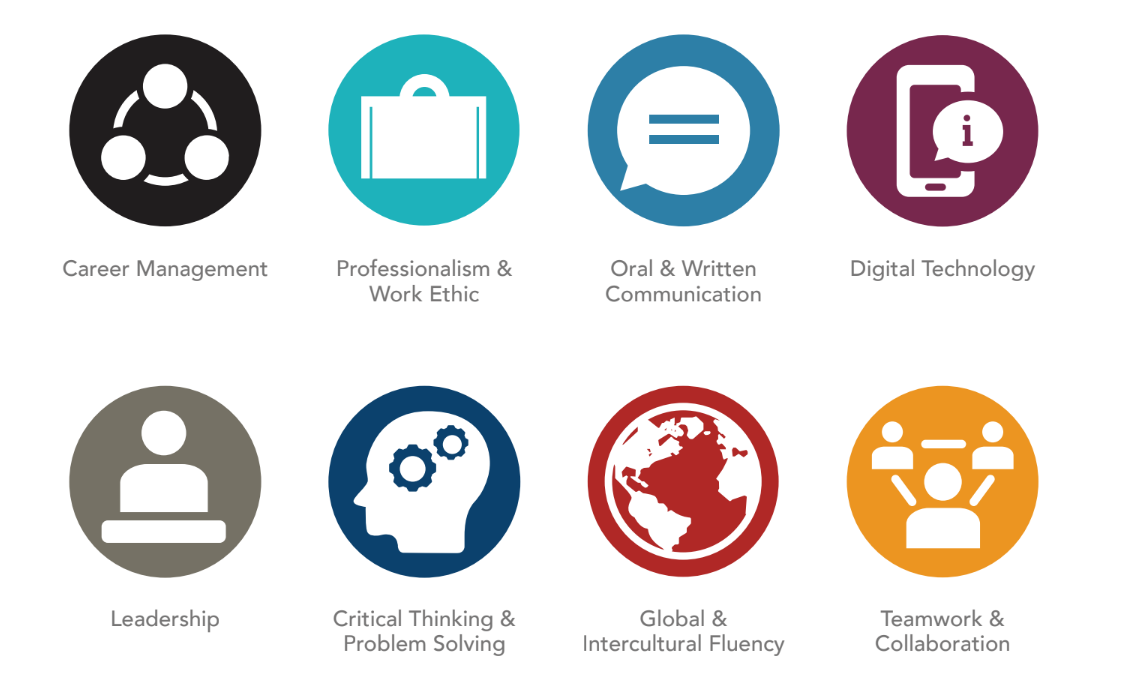
The NACE Competencies are a popular jumping-off point for the creation of custom competency frameworks.
If you’ve followed our content here at Suitable, you’ve heard us recommend competency frameworks before. But in a world where students feel a lack of communication from their university and struggle to see the big picture, establishing a structure is key.
A competency framework provides a great starting point for injecting career services into your student experience.
Start At The End
For most college students, their perfect career is the logical endpoint to any successful college experience. 88% of first-year students report future employment as their reason for attending college in the first place.
So why not start at the end by asking employers what they look for in qualified job candidates?
That’s what University of Pittsburgh’s School of Business did when they adapted their student engagement program The Outside The Classroom Curriculum. In 2019, Pitt Business hired Jess Druga as their Student Engagement Manager. Her first act in her new role was to engage the business school’s robust employer partner network to help her create a business-school-specific competency framework designed around qualities employers said they are looking for in a potential new hire.
To give you an idea, here are the competencies Jess and her employer network came up with:
- Leadership Development
- Career & Professional Development
- Communication Skills
- Cross-Functional Team Management
- Personal Financial Literacy & Wellness
- Global & Cultural Engagement
- Pitt Engagement
- Network & Relationship Management
- Business Acumen
- Civic & Social Engagement
Demonstrate Values & Accountability to Prospective Parents & Students
Whether the future of college is virtual, in-person or a mix of the two, the modern university’s role is changing, and it can be hard for students and parents to fully understand how these new environments will translate to learning and earning.
Establishing a competency framework outlines a roadmap for students from where they are today to the careers they want. It’s a mechanism to communicate to students why their co-curricular involvement is valuable while providing “guideposts” along the way that are clear measures of progress. Students are more likely to be successful when they can realize and visualize progress themselves. It also offers parents and prospective students an unfiltered view into what makes your school’s education so unique, your school’s mission and vision, and how your school will be intentional about helping each new student get where they want to go.
Create Scheduled Benchmarks and Interventions
As students progress through their education, some may fall behind. When schools can intervene at opportune times, it can make a tremendous difference to the trajectory of their education.
By establishing a competency framework and tracking progress towards these competencies, schools can more effectively see which students are falling behind and intervene where necessary.
Scaffold Competencies With Gamification
.png?width=2240&name=Blog%20Banners%20(5).png)
Once you have your competency framework in place, you must engage students so they actively work towards achieving benchmarks within the framework. This will help your students in several important ways.
Activities, Events & Assignments Tied To Each Competency
By scaffolding competencies with specific activities inside and outside the classroom, you’ll show students not only what they need to achieve to land that perfect job, but how to get there--step by step, day by day.
By building achievements into your program, you’ll incentivize students to do the work only they can do, and encourage them to keep it up, even when the going gets tough.
Achievements and digital badges let students know they are on the right track. Once they know what it takes to achieve within a certain competency, they’ll begin to develop a clearer picture of their strengths and weaknesses and even what they enjoy and what they don’t.
Create A Mobile-First Approach
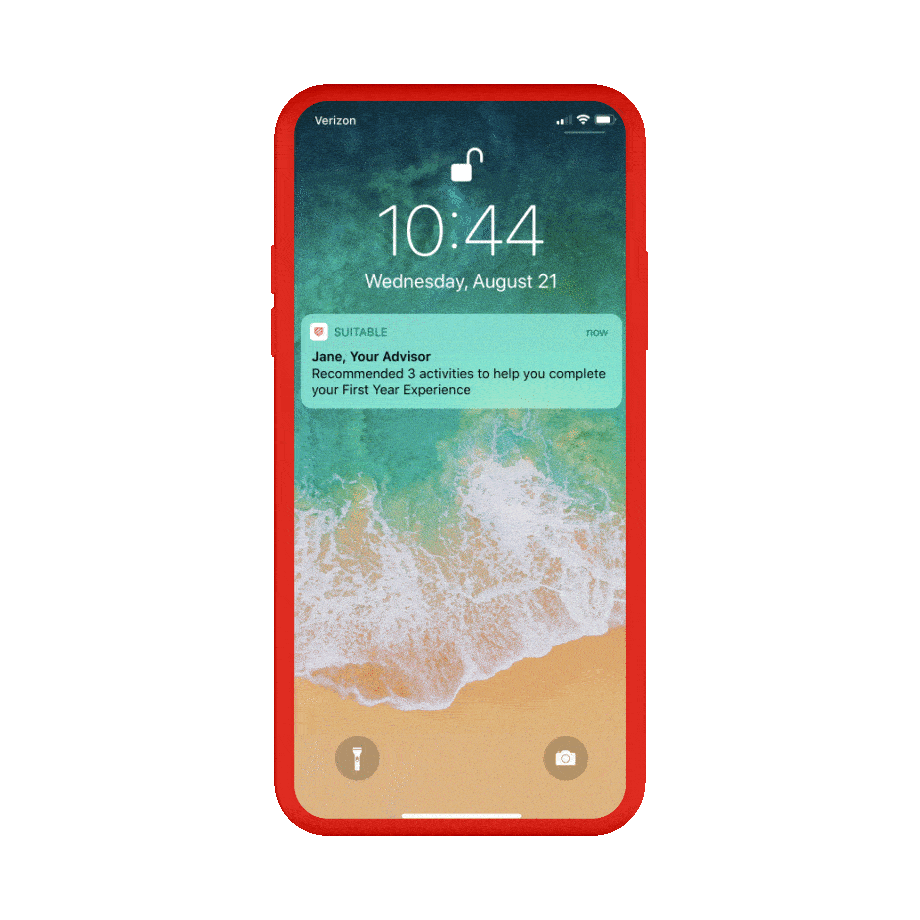
Suitable's Mobile Notification Workflow
As an educator, it may seem counterintuitive to encourage students to spend MORE time on their phones. But the truth is that the phone is quickly becoming the most inclusive and accessible channel to communicate with students.
According to a 2018 Pew Research Center study, lower income students are dramatically less likely to come into college with reliable access to a computer. A comparable Inside Higher Ed report showed that state schools and community colleges are struggling to deliver content to students who only have access to a smartphone.
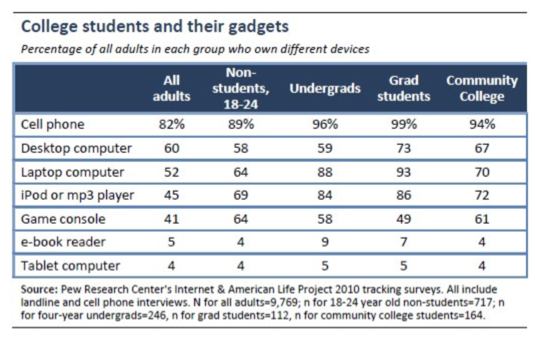
Even when students do have access to a computer, our university partners estimate that they send students, on average, nearly 400 emails per semester. Today's students report using email less frequently than ever before. It is no wonder then that so many students feel disconnected from Career Services and other university resources.
By establishing a mobile-first approach, schools meet students where they expect to be met and can shift to in-app or text-based communication, which dramatically improves student response. Schools can deliver timely updates, achievement incentives and needed interventions using real-time notifications that actually get read.
Achievements, Incentives & Badges
According to the Pew Research study cited above, 90% of Generation Z report playing mobile video games on a consistent basis.
If you want to engage your students, why not gamify their experience?
Much like the video games students love, scaffolding competencies create levels with defined activities and goals. When a student completes a level, they feel a sense of gratification instantly.
Some schools simply provide a badge. Others use a leaderboard to incentivize competition between individual students and groups. Others, like the University of Pittsburgh Business School partner with employers to provide professional opportunities, access to events and even interviews for students who complete the program at the highest levels.
Career Readiness Articulation
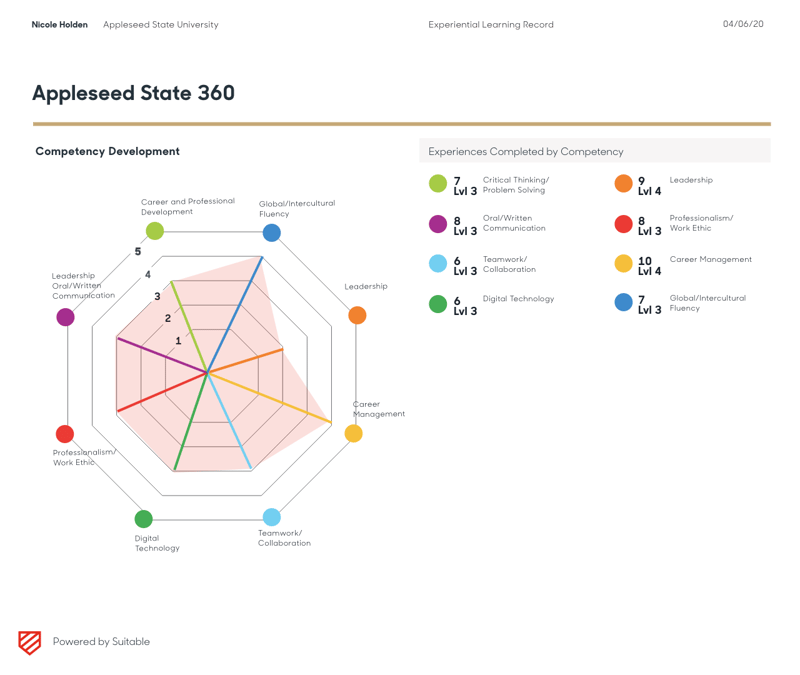
Well, this is it. Your students have come to the end of their academic journey and it is time for them to move into the workforce or apply to grad school. What can your university arm them with to help them confidently seize that next opportunity?
By providing every student with a record of their involvement that articulates their career readiness, your university can give each and every student the tools they need to tell their professional story to employers. What have they accomplished over their time in college that they can use to put their best foot forward?
Transcripts are great but they don’t tell the whole story. That’s why each student enrolled in a Suitable program receives an Experiential Learning Record--a full accounting of all the experiences they have had while on campus, translated into competencies. This record will tell the student’s story in four distinct parts.
The Student Overview
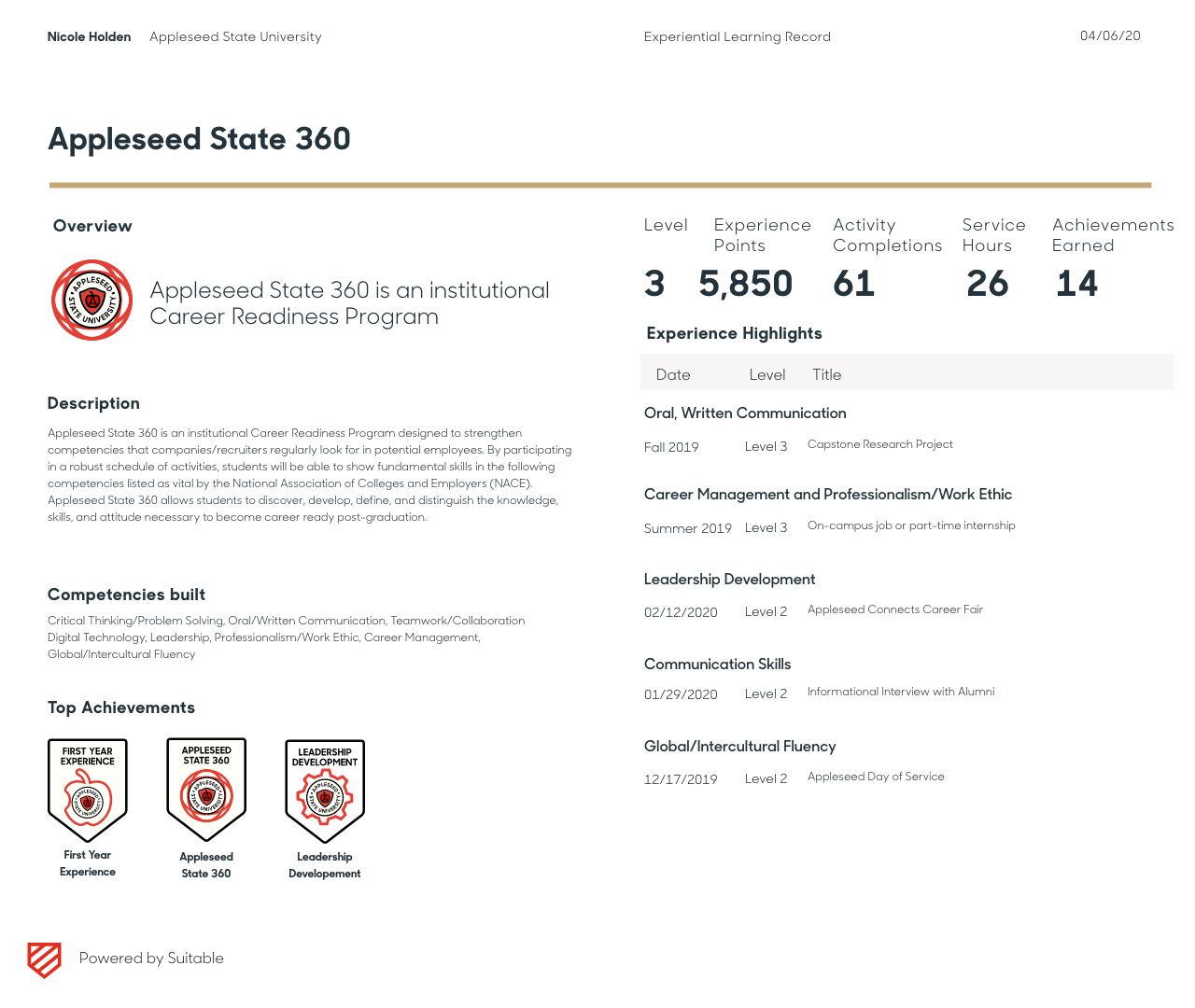
The Overview highlights the student's completion of specific High Impact Practices, Achievements, and Milestones.
The Experience Showcase
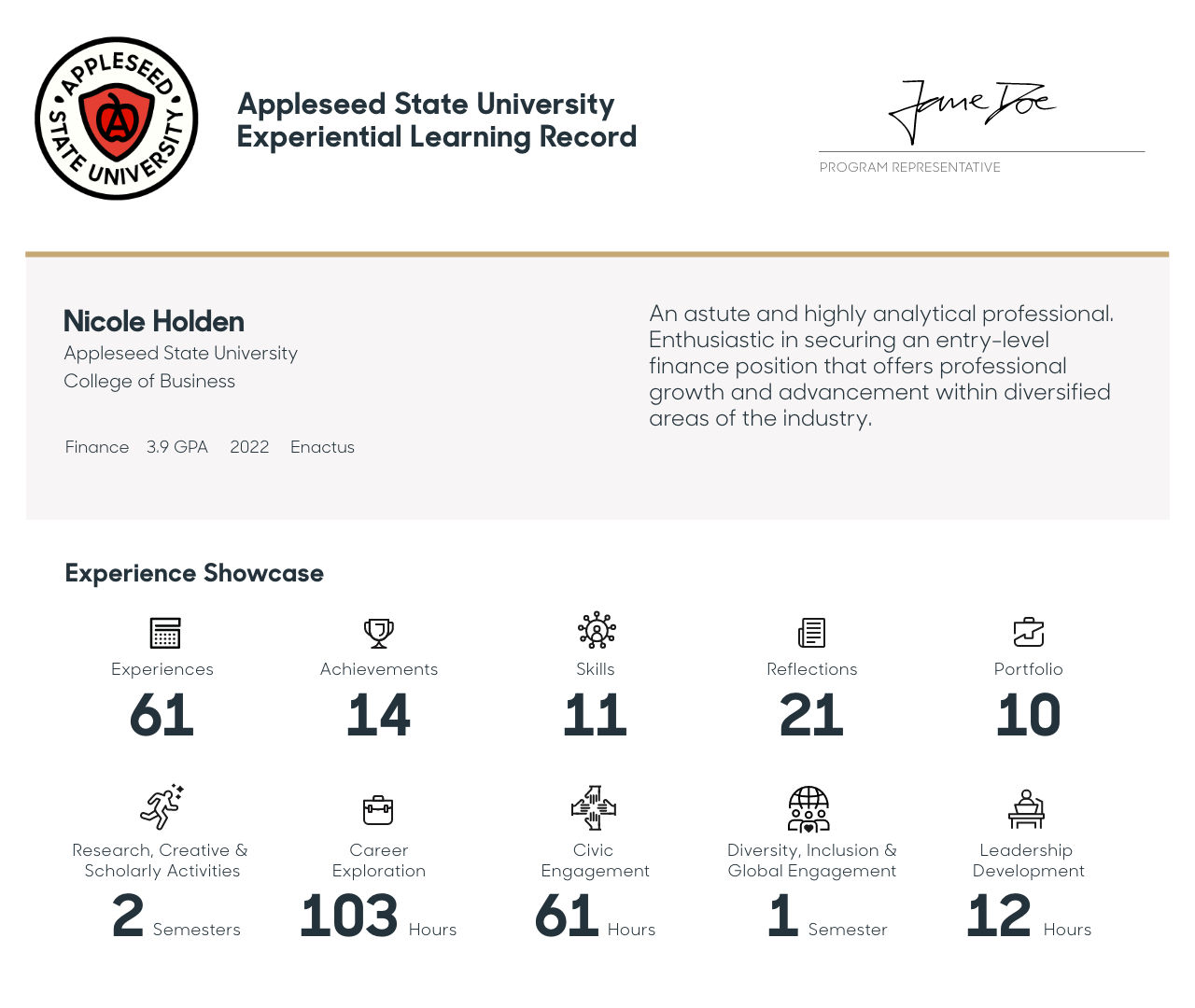
The Experience Showcase gives your students a quantitative way to tell their story.
The Timeline
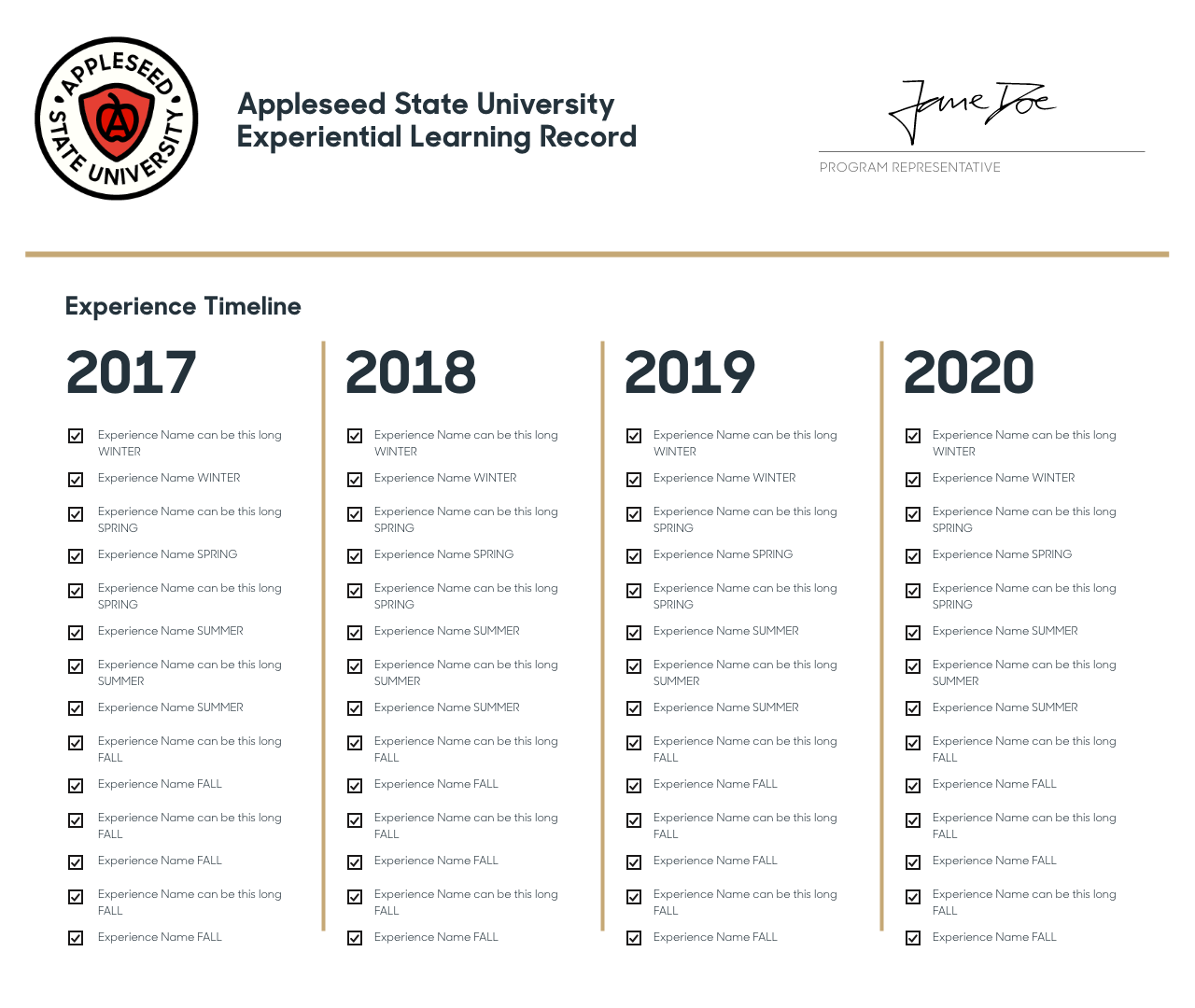
The Timeline mirrors your average co-curricular transcript, reminding students when they had certain experiences and offering advising teams a year-by-year view of their engagement.
The Competency Map
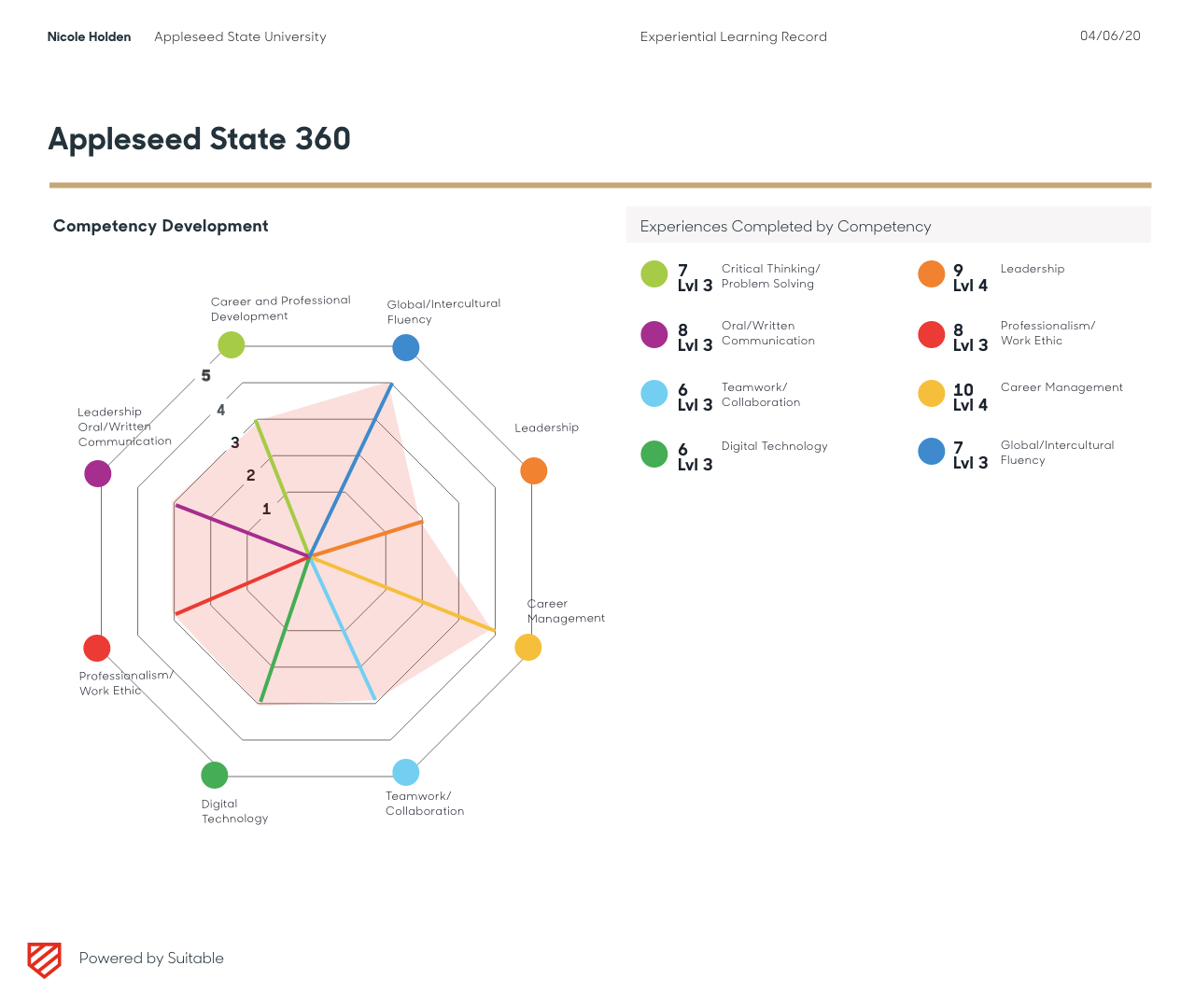
The Competency Map articulates how a student's engagement and experiences translate to valuable skills and competencies necessary for lifelong success.
By following this process, your school can address the intimidation students feel on campus, infuse career-readiness opportunities right into the daily lives of students and create valuable partnerships with local and national employers. The post-pandemic career services model is within your reach. To learn more, reach out to Suitable today!


